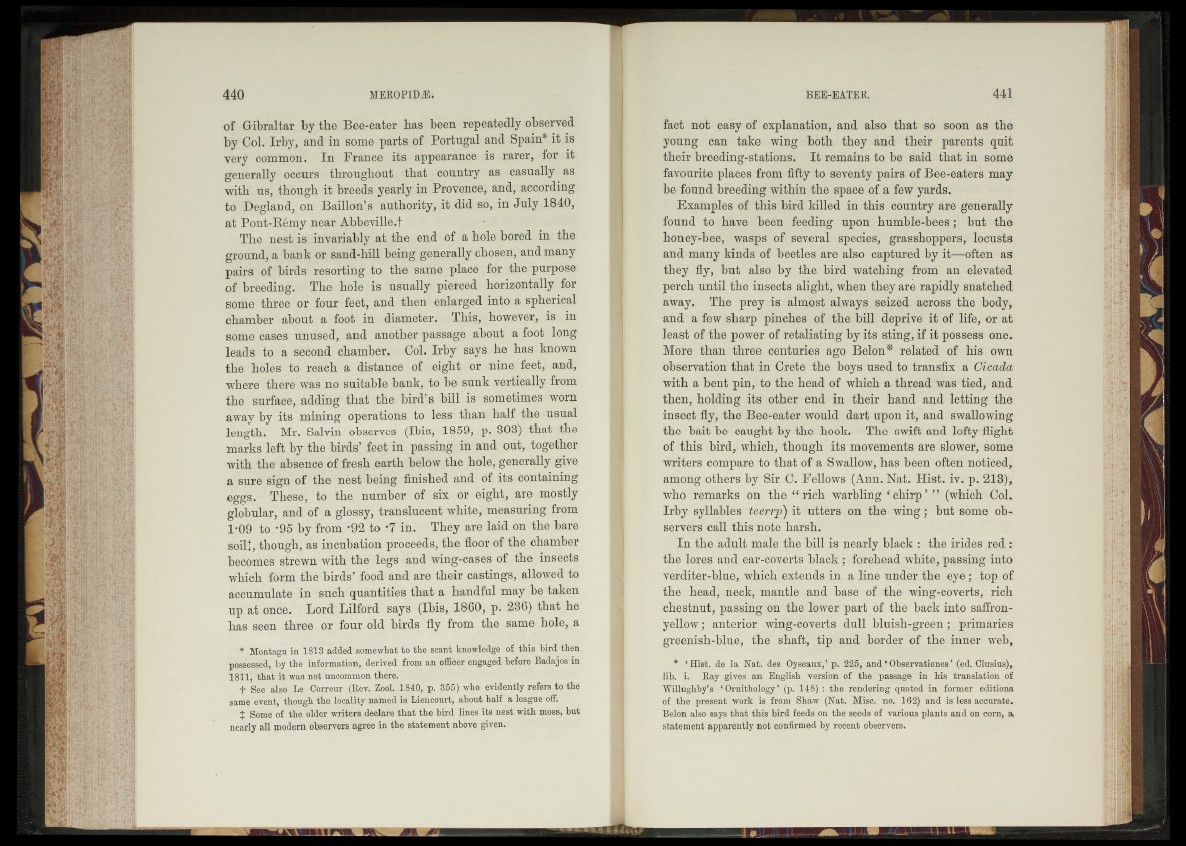
of Gibraltar by tbe Bee-eater has been repeatedly observed
by Col. Irby, and in some parts of Portugal and Spain* it is
very common. In France its appearance is rarer, for it
generally occurs throughout that country as casually as
with us, though it breeds yearly in Provence, and, according
to Degland, on Baillon’s authority, it did so, in July 1840,
at Pont-Remy near Abbeville.f
The nest is invariably at the end of a hole bored in the
ground, a bank or sand-hill being generally chosen, and many
pairs of birds resorting to the same place for the purpose
of breeding. The hole is usually pierced horizontally for
some three or four feet, and then enlarged into a spherical
chamber about a foot in diameter. This, however, is in
some cases unused, and another passage about a foot long
leads to a second chamber. Col. Irby says he has known
the holes to reach a distance of eight or nine feet, and,
where there was no suitable bank, to be sunk vertically from
the surface, adding that the bird’s bill is sometimes worn
away by its mining operations to less than half the usual
length. Mr. Salvin observes (Ibis, 1859, p. 308) that the
marks left by the birds’ feet in passing in and out, together
with the absence of fresh earth below the hole, generally give
a sure sign of the nest being finished and of its containing
eggs. These, to the number of six or eight, are mostly
globular, and of a glossy, translucent white, measuring from
1*09 to -95 by from -92 to *7 in. They are laid on the bare
soil!, though, as incubation proceeds, the floor of the chamber
becomes strewn with the legs and wing-cases of the insects
which form the birds’ food and are their castings, allowed to
accumulate in such quantities that a handful may be taken
up at once. Lord Lilford says (Ibis, 1860, p. 286) that he
has seen three or four old birds fly from the same hole, a
* Montagu in 1813 added somewhat to the scant knowledge of this bird then
possessed, by the information, derived from an officer engaged before Badajos in
1811, that it was not uncommon there.
f See also Le Correur (Rev. Zool. 1840, p. 355) who evidently refers to the
same event, though the locality named is Liencourt, about half a league off.
+ Some of the older writers declare that the bird lines its nest with moss, but
nearly all modern observers agree in the statement above given.
fact not easy of explanation, and also that so soon as the
young can take wing both they and their parents quit
their breeding-stations. It remains to be said that in some
favourite places from fifty to seventy pairs of Bee-eaters may
be found breeding within the space of a few yards.
Examples of this bird killed in this country are generally
found to have been feeding upon humble-bees; but the
honey-bee, wasps of several species, grasshoppers, locusts
and many kinds of beetles are also captured by it—often as
they fly, but also by the bird watching from an elevated
perch until the insects alight, when they are rapidly snatched
away. The prey is almost always seized across the body,
and a few sharp pinches of the bill deprive it of life, or at
least of the power of retaliating by its sting, if it possess one.
More than three centuries ago Belon* related of his own
observation that in Crete the boys used to transfix a Cicada
with a bent pin, to the head of which a thread was tied, and
then, holding its other end in their hand and letting the
insect fly, the Bee-eater would dart upon it, and swallowing
the bait be caught by the hook. The swift and lofty flight
of this bird, which, though its movements are slower, some
writers compare to that of a Swallow, has been often noticed,
among others by Sir C. Fellows (Ann. Nat. Hist. iv. p. 213),
who remarks on the “ rich warbling ‘ chirp’ ” (which Col.
Irby syllables teerrp) it utters on the wing; but some observers
call this note harsh.
In the adult male the bill is nearly black : the irides red :
the lores and ear-coverts black ; forehead white, passing into
verditer-blue, which extends in a line under the eye; top of
the head, neck, mantle and base of the wing-coverts, rich
chestnut, passing on the lower part of the back into saffron-
yellow ; anterior wing-coverts dull bluish-green; primaries
greenish-blue, the shaft, tip and border of the inner web,
* ‘Hist, de la Nat. des Oyseaux,’ p. 225, and ‘Observationes’ (ed. Clnsius),
lib. i. Ray gives an English version of the passage in his translation of
Willughby’s ‘Ornithology’ (p. 148) : the rendering quoted in former editions
of the present work is from Shaw (Nat. Misc. no. 162) and is less accurate.
Belon also says that this bird feeds on the seeds of various plants and on corn, a
statement apparently not confirmed by recent observers.